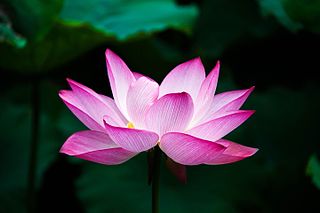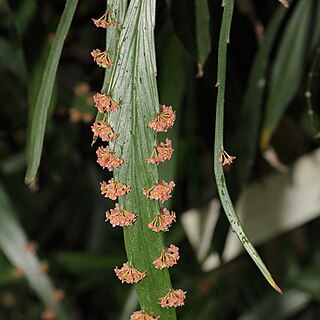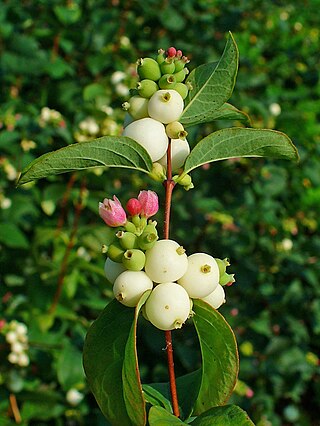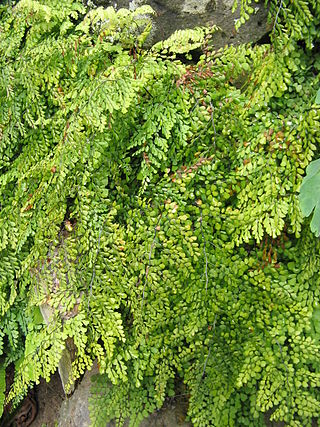
Spearmint, a species of mint (mentha) scientifically classified as Mentha spicata (,) also known as garden mint, common mint, lamb mint and mackerel mint, is native to Europe and southern temperate Asia, extending from Ireland in the west to southern China in the east. It is naturalized in many other temperate parts of the world, including northern and southern Africa, North America, and South America. It is used as a flavouring in food and herbal teas. The aromatic oil, called oil of spearmint, is also used as a flavoring and sometimes as a scent.

Ilex opaca, the American holly, is a species of holly, native to the eastern and south-central United States, from coastal Massachusetts south to central Florida, and west to southeastern Missouri and eastern Texas.

Symphoricarpos, commonly known as the snowberry, waxberry, or ghostberry, is a small genus of about 15 species of deciduous shrubs in the honeysuckle family, Caprifoliaceae. With the exception of the Chinese coralberry, S. sinensis, which is indigenous to western China, all species are native to North and Central America. The name of the genus is derived from the Ancient Greek words συμφορεῖν (sumphoreîn), meaning "to bear together", and καρπός (karpós), meaning "fruit". It refers to the closely packed clusters of berries the species produces.

Nelumbo nucifera, also known as sacred lotus, Indian lotus, or simply lotus, is one of two extant species of aquatic plant in the family Nelumbonaceae. It is sometimes colloquially called a water lily, though this more often refers to members of the family Nymphaeaceae.

Solanum nigrum, the European black nightshade or simply black nightshade or blackberry nightshade, is a species of flowering plant in the family Solanaceae, native to Eurasia and introduced in the Americas, Australasia, and South Africa. Ripe berries and cooked leaves of edible strains are used as food in some locales, and plant parts are used as a traditional medicine. Some other species may also be referred to as "black nightshade".

Spartium junceum, known as Spanish broom, rush broom, or weaver's broom, it is a species of flowering plant in the family Fabaceae and the sole species in the genus Spartium. It is closely related to the other brooms.

Dioscorea communis or Tamus communis is a species of flowering plant in the yam family Dioscoreaceae and is commonly known as black bryony, lady's-seal or black bindweed.

Ruscus, commonly known as butcher's broom, is a genus of six species of flowering plants, native to western and southern Europe, Macaronesia, northwestern Africa, and southwestern Asia east to the Caucasus. In the APG III classification system, it is placed in the family Asparagaceae, subfamily Nolinoideae. Like many lilioid monocots, it was formerly classified in the family Liliaceae.

Calendula officinalis, the pot marigold, common marigold, ruddles, Mary's gold or Scotch marigold, is a flowering plant in the daisy family Asteraceae. It is probably native to southern Europe, though its long history of cultivation makes its precise origin unknown. It is also widely naturalised farther north in Europe and elsewhere in warm temperate regions of the world.

Phylloclades and cladodes are flattened, photosynthetic shoots, which are usually considered to be modified branches. The two terms are used either differently or interchangeably by different authors. Phyllocladus, a genus of conifer, is named after these structures. Phylloclades/cladodes have been identified in fossils dating from as early as the Permian.

Barringtonia acutangula is a species of Barringtonia native to coastal wetlands in southern Asia and northern Australasia, from Afghanistan east to the Philippines, Queensland and the Northern Territory. Common names include freshwater mangrove, itchytree and mango-pine.

Chamaelirium is a genus of flowering plants containing the single species Chamaelirium luteum, commonly known as blazing-star, devil's bit, false unicorn, fairy wand, and helonias. It is a perennial herb native to the eastern United States. It can be found in a variety of habitats, including wet meadows and deciduous woodlands.

Symphoricarpos albus is a species of flowering plant in the honeysuckle family known by the common name common snowberry. Native to North America, it is browsed by some animals and planted for ornamental and ecological purposes, but is poisonous to humans.

Ruscus hypoglossum is a small evergreen shrub with a native range from Italy north to Austria and Slovakia and east to Turkey and Crimea. Common names include spineless butcher's-broom, mouse thorn and horse tongue lily. The species name comes from two Greek words ὑπό (hypo) and γλῶσσα (glōssa) meaning under and tongue.

Pittosporum angustifolium is a shrub or small tree growing throughout inland Australia. Common names include weeping pittosporum, butterbush, cattle bush, native apricot, apricot tree, gumbi gumbi, cumby cumby, meemeei, poison berry bush, and berrigan.

Adiantum venustum, the evergreen maidenhair or Himalayan maidenhair, is a species of fern in the genus Adiantum of the family Pteridaceae, native to China and the Himalayas. It is a slow to establish plant that usually grows on moist rocks and soil with a good amount of humus and dead leaves. It is very hardy, largely evergreen to -10 °C, when it becomes deciduous. It is also known as black Hansraj in India for its black stalks at the fronds.

Ficus auriculata is a type of fig tree, native to subtropical parts of Asia. It is noted for its big and round leaves and edible fruit.

Sarcococca ruscifolia (野扇花) is a species of flowering plant in the box family Buxaceae, native to China, where it inhabits forested mountain slopes. Growing to 1 m (3.3 ft) tall and broad, it is a compact evergreen shrub with shiny oval leaves. Fragrant white flowers in winter are followed by red berries.

Ruscus hyrcanus is a perennial evergreen woody shrub-like or small compact bush plant. It is in the asparagus family.
Manilkara obovata is small to large sized evergreen tree within the Sapotaceae family. Its timber is sold under the name Nkunya in Uganda. The species has a wide distribution from Sierra Leone in West Africa moving east to Uganda in Eastern Africa and southwards to Zambia. It is also considered a variable species having different ecotypes.























